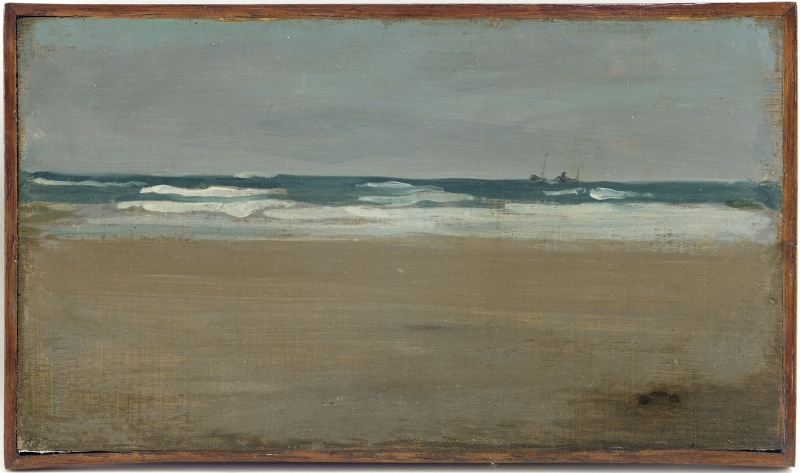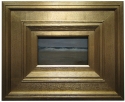Technique
The panel is painted thinly, with fine brushwork, on a panel prepared with a grey ground. Both beach and sky were smoothed into an even tone, contrasting with the thicker, creamy brushstrokes on the breakers.
The unusually elongated form of the butterfly is not in the form used in the 1880s, and may have been added later, possibly about 1901.
Years after they had worked together in St Ives, Walter Richard Sickert (1860-1942) commented enthusiastically on Whistler's technique in such small panels as this:
'I imagine that, with time, it will be seen that Whistler expressed the essence of his talent in his little panels, pochades, it is true, in measurement, but masterpieces of classic painting in importance. While his maturer etching inclined to a superficial hinting, to a witty suggestion, of form, what our national critic has called “pirouetting on paper,” the paintings have always weight. The relation and keeping of the tone is marvellous in its severe restriction. It is this that is strong painting. No sign of effort, with immense result. He will give you in a space nine inches by four an angry sea, piled up, and running in, as no painter ever did before. The extraordinary beauty and truth of the relative colours, and the exquisite precision of the spaces, have compelled infinity and movement into an architectural formula of eternal beauty. Never was instrument better understood and more fully exploited than Whistler has understood and exploited oil paint in these panels. He has solved in them a problem that had hitherto seemed insoluble: to give a result of deliberateness to a work doe in a few hours from nature. It was the admirable preliminary order in his mind, the perfect peace at which his art was with itself, that enabled him to aim at and bring down quarry which, to anyone else, would have seemed intangible and altogether elusive.' 1
Conservation History
Freer Gallery files record that the varnish was removed in 1921, at which time there were some signs of repainting; and that it was resurfaced in 1938 and 1942, and cleaned and resurfaced in 1922 and 1951.
Frame
1884: the original frame, described as 'green-gold', and specially made for the Dowdeswell exhibition, has not been not located
A flattering review in the Court Circular in 1884 commented on the original picture frame:
'This wonderful artist uses frames of greenish gold wherever the picture requires such a setting, noticeably for his marine studies. A strip of angry grey-green sea, framed in green gold, against a dull pink background, is an exquisite arrangement of colour, worthy to be adopted by the costumiere [sic] pf the period.' 2
It is in a replica Dowdeswell frame, American, made by W. Lewin, 2004. 3
Last updated: 8th June 2021 by Margaret







